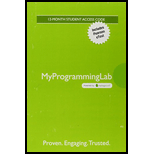
Concept explainers
Explanation of Solution
Edge array of given graph:
int[][] edges = {{0, 1}, {0, 2}, {0, 3}, {0, 4}, {0, 5},{1, 0}, {1, 2}, {1, 3}, {1, 4}, {2, 0}, {2, 1}, {2, 3}, {2, 4},{3, 0}, {3, 1}, {3, 2}, {3, 4}, {3, 5},{4, 0}, {4, 1}, {4, 2}, {4, 3},{5, 0}, {5, 3}}
Explanation:
Here, “int[][]” is the data type of two dimensional array with variable “edges”. The edges values are initialized into an array.
List of edge objects for given graph:
java.util.ArrayList<Edge> list = new java.util.ArrayList<Edge>();
list.add(new Edge(0, 1));
list.add(new Edge(0, 2));
list.add(new Edge(0, 3));
list.add(new Edge(0, 4));
list.add(new Edge(0, 5));
Explanation:
Here, the object “list” for class “ArrayList<>” is initialized with “edge” object. Then the edge values added into list.
Adjacency matrix for given graph:
int[][] adjacencyMatrix = {
{0, 1, 1, 1, 1, 1}, // node 0
{1, 0, 1, 1, 1, 0}, // node 1
{1, 1, 0, 1, 1, 0}, // node 2
{1, 1, 1, 0, 1, 1}, // node 3
{1, 1, 1, 1, 0, 0}, // node 4
{1, 0, 0, 1, 0, 0} // node 5
};
Explanation:
Here, the variable “adjacencyMatrix” in declared in type of two dimensional integer “int[][]” and the adjacency values are initialized into it.
Adjacency vertex list:
LinkedList<Integer> list[] = new LinkedList<>();
list[0].add(1); list[0].add(2); list[0].add(3); list[0].add(4); list[0].add(5);
list[1].add(0); list[1].add(2); list[1].add(3); list[1].add(4);
list[2].add(0); list[2].add(1); list[2].add(3); list[2]...
Want to see the full answer?
Check out a sample textbook solution
Chapter 28 Solutions
MyLab Programming with Pearson eText -- Access Card -- for Introduction to Java Programming and Data Structures, Comprehensive Version
- List down the strenghts and weaknesses of your team project for Capsim Simulation? Explan.arrow_forwardCapsim Team PowerPoint Presentations - Slide Title: Key LearningsWhat were the key learnings that you discovered as a team through your Capsim simulation?arrow_forwardWrite the SQL code that permits to implement the tables: Student and Transcript. NB: Add the constraints on the attributes – keys and other.arrow_forward
- Draw an ERD that will involve the entity types: Professor, Student, Department and Course. Be sure to add relationship types, key attributes, attributes and multiplicity on the ERD.arrow_forwardDraw an ERD that represents a book in a library system. Be sure to add relationship types, key attributes, attributes and multiplicity on the ERD.arrow_forward2:21 m Ο 21% AlmaNet WE ARE HIRING Experienced Freshers Salesforce Platform Developer APPLY NOW SEND YOUR CV: Email: hr.almanet@gmail.com Contact: +91 6264643660 Visit: www.almanet.in Locations: India, USA, UK, Vietnam (Remote & Hybrid Options Available)arrow_forward
- Provide a detailed explanation of the architecture on the diagramarrow_forwardhello please explain the architecture in the diagram below. thanks youarrow_forwardComplete the JavaScript function addPixels () to calculate the sum of pixelAmount and the given element's cssProperty value, and return the new "px" value. Ex: If helloElem's width is 150px, then calling addPixels (hello Elem, "width", 50) should return 150px + 50px = "200px". SHOW EXPECTED HTML JavaScript 1 function addPixels (element, cssProperty, pixelAmount) { 2 3 /* Your solution goes here *1 4 } 5 6 const helloElem = document.querySelector("# helloMessage"); 7 const newVal = addPixels (helloElem, "width", 50); 8 helloElem.style.setProperty("width", newVal); [arrow_forward
 C++ Programming: From Problem Analysis to Program...Computer ScienceISBN:9781337102087Author:D. S. MalikPublisher:Cengage Learning
C++ Programming: From Problem Analysis to Program...Computer ScienceISBN:9781337102087Author:D. S. MalikPublisher:Cengage Learning EBK JAVA PROGRAMMINGComputer ScienceISBN:9781337671385Author:FARRELLPublisher:CENGAGE LEARNING - CONSIGNMENT
EBK JAVA PROGRAMMINGComputer ScienceISBN:9781337671385Author:FARRELLPublisher:CENGAGE LEARNING - CONSIGNMENT- Programming Logic & Design ComprehensiveComputer ScienceISBN:9781337669405Author:FARRELLPublisher:Cengage
 EBK JAVA PROGRAMMINGComputer ScienceISBN:9781305480537Author:FARRELLPublisher:CENGAGE LEARNING - CONSIGNMENT
EBK JAVA PROGRAMMINGComputer ScienceISBN:9781305480537Author:FARRELLPublisher:CENGAGE LEARNING - CONSIGNMENT C++ for Engineers and ScientistsComputer ScienceISBN:9781133187844Author:Bronson, Gary J.Publisher:Course Technology Ptr
C++ for Engineers and ScientistsComputer ScienceISBN:9781133187844Author:Bronson, Gary J.Publisher:Course Technology Ptr





